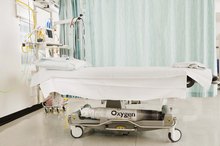Roles of Operating Room Personnel
A successful surgery requires the close cooperation of many operating room personnel. They must all know their roles and responsibilities and be prepared to execute them quickly and confidently. A newcomer to the interaction of so many medical workers can easily be overwhelmed. As with most unfamiliar experiences, a little pre-emptive preparation can go a long way toward alleviating anxiety and confusion.
Surgeons
Surgeons are often thought of as the captains of the ship. It is their responsibility to ensure that the operation proceeds smoothly and without complications. They direct the nursing personnel and assistants in the steps of the operations and work closely with the anesthesiologists in the management of the patient's condition. A standard surgical team will have one senior surgeon (known as the "attending") and one resident surgeon in the process of completing his five-year residency training. More complicated operations can involve three or even four surgeons working together.
- Surgeons are often thought of as the captains of the ship.
- A standard surgical team will have one senior surgeon (known as the "attending") and one resident surgeon in the process of completing his five-year residency training.
Anesthesiologists
Difference Between RN & LPN Assessment
Learn More
The anesthesiologist is the physician in charge of the maintenance of the patient's level of consciousness, pain-numbing medication, heart rate, blood pressure and respiration. Typically, a patient will meet with the anesthesiologist before the surgery to discuss medication options and any history of allergic reactions. The anesthesiologist will then give the patient medication to help with anxiety before they are brought into the operating room, then for a complex operation might induce unconsciousness and paralysis and insert a tube to take control of the patient's breathing. For less complex operations, the anesthesiologist might numb the involved area locally or with a spinal or epidural block. As technology increases, the anesthesiologist's job becomes more complicated because of the array of tools available and simpler because of the advanced monitoring equipment.
- The anesthesiologist is the physician in charge of the maintenance of the patient's level of consciousness, pain-numbing medication, heart rate, blood pressure and respiration.
- The anesthesiologist will then give the patient medication to help with anxiety before they are brought into the operating room, then for a complex operation might induce unconsciousness and paralysis and insert a tube to take control of the patient's breathing.
Nurses
Two to four nurses are normally present in the operating room during surgery 1. One of these is the scrub nurse. This nurse is "scrubbed in," or wearing a special sterile gown and gloves, and is in charge of the instruments used during the operation. The scrub nurse anticipates what the surgeon will need, passes the instruments to the surgeon as requested, keeps track of where every instrument and piece of gauze is during the operation and prepares samples for biopsy. The circulating nurse is not scrubbed in and therefore has more freedom to move around and outside the operating room. They retrieve supplies that were not gathered before the surgery, open their nonsterile outer wrappings to expose the sterile interior for the scrub nurse, and assist with the typically large amounts of paperwork all operating room personnel must complete.
- Two to four nurses are normally present in the operating room during surgery 1.
- This nurse is "scrubbed in," or wearing a special sterile gown and gloves, and is in charge of the instruments used during the operation.
Students
Types of Services in Hospitals
Learn More
If the hospital is a teaching hospital, there will typically be a number of students present to observe and sometimes assist with the surgery. Some of these will be medical students. One or two of the medical students often will have the opportunity to scrub in with the surgeon and perform some simple tasks such as suctioning. There might also be nursing students present to assist the nurses with their tasks.
- If the hospital is a teaching hospital, there will typically be a number of students present to observe and sometimes assist with the surgery.
- One or two of the medical students often will have the opportunity to scrub in with the surgeon and perform some simple tasks such as suctioning.
Related Articles
References
- "Journal of the American College of Surgeons;" Operating Room Teamwork among Physicians and Nurses: Teamwork in the Eye of the Beholder; M. Makary, J. Sexton, J. Freischlag, C. Holzmueller, E. Millman, L. Rowen, P. Pronovost; May 2006
- "The Journal of Nursing Administration;" Improving Operating Room Coordination: Communication Pattern Assessment; Moss, Jacqueline PhD, RN; Xiao, Yan PhD; February 2004
Writer Bio
Ryan Doss began writing professionally in 2009 and has been published on LIVESTRONG.COM and eHow. He is a resident physician in emergency medicine. Doss has an M.D. from Ross University School of Medicine and a Bachelor of Arts in history and philosophy of science from the University of Washington.








